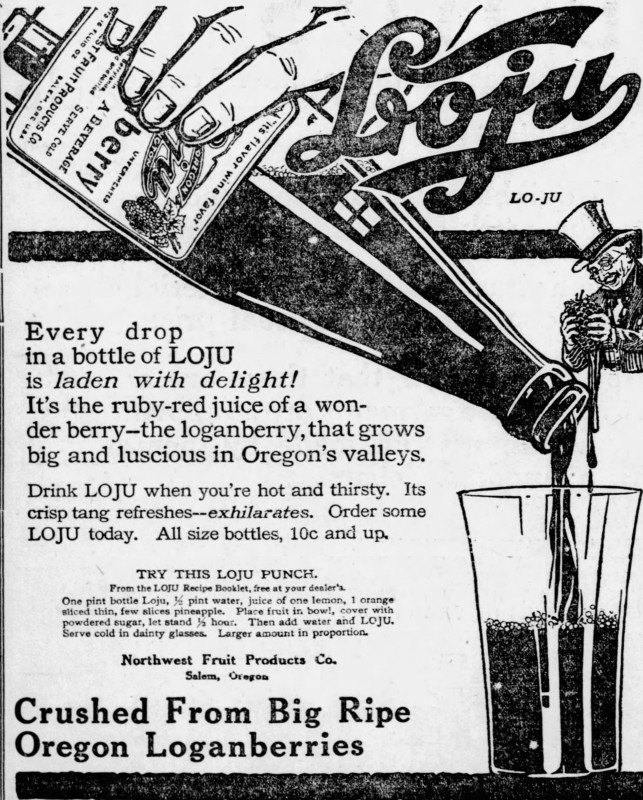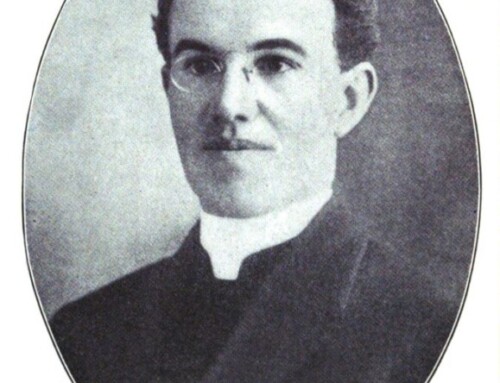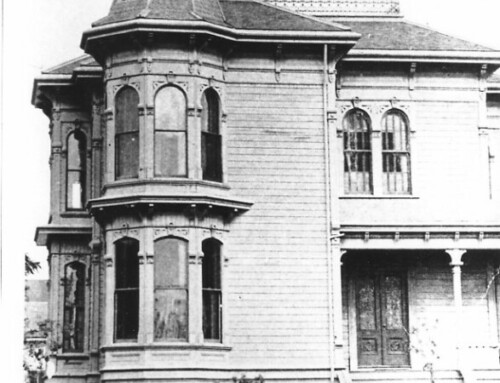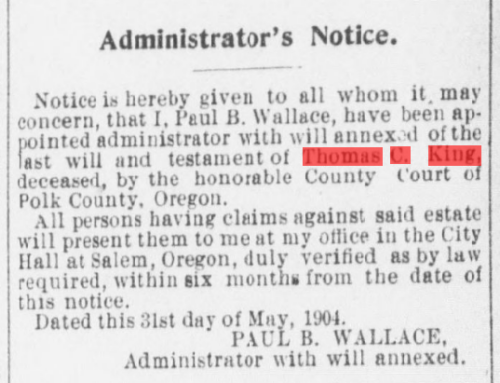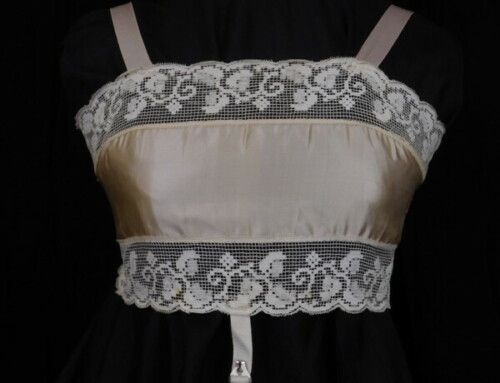Beer made Milwaukee famous and the loganberry promises to do the same thing on a larger scale for Salem and the Willamette Valley.[1]
Despite the hype, this prediction never really came true. While loganberries are still grown here, it is not to the national fanfare that many early farmers and industrialists had hoped and predicted.
The story was very different a century ago. The industry seemed to be teetering on the edge of huge breakthrough. With the abolition of alcohol sales locally in 1913[2] and across the country in 1919,[3] many local companies banked their marketing bucks on national campaigns to help promote their loganberry juice as a refreshing (and legal) alternative to alcohol. They even went so far as to create pamphlets with loganberry “mocktail” recipes and slogans like “A man’s drink, a women’s friend.”[4]
With a new, untapped market, local papers churned out full page spreads encouraging local farmers to get into the industry. Articles promised “sure profits; contracts that are gilt edged. Men who know are now going into loganberries so fast that there may be a shortage of loganberry tips by next spring…and still the cry is for more loganberries, from the factories in Salem.”[5]
The Beginnings
The crop was a relative newcomer to the Willamette Valley. According to his own advertising, the first Loganberry plants were “introduced” to Salem by Gus. Freniard, a farmer who lived on Fairgrounds Road, in 1899.[6] [7] Newspaper advertisements indicate that by 1900, in addition to selling his own plants, Freniard was also providing stock for various seed sellers, which described the new berry as “a cross between the Blackberry and Red Raspberry …[it is] the largest and finest and most prolific berry extant, color dark red.”[8]
The berry itself was not developed or discovered here. Rather, that distinction goes to Judge James Harvey Logan,[9] who accidentally crossed his Auginbaugh Blackberry and Antwerp red raspberry vines[10] in his garden in Santa Cruz, California[11] in 1881.[12] As a side note, Judge Logan did make it to Salem in 1922, where he was honored with a reception at the State Fair.[13]
Salem as Loganberry Cultivation Center
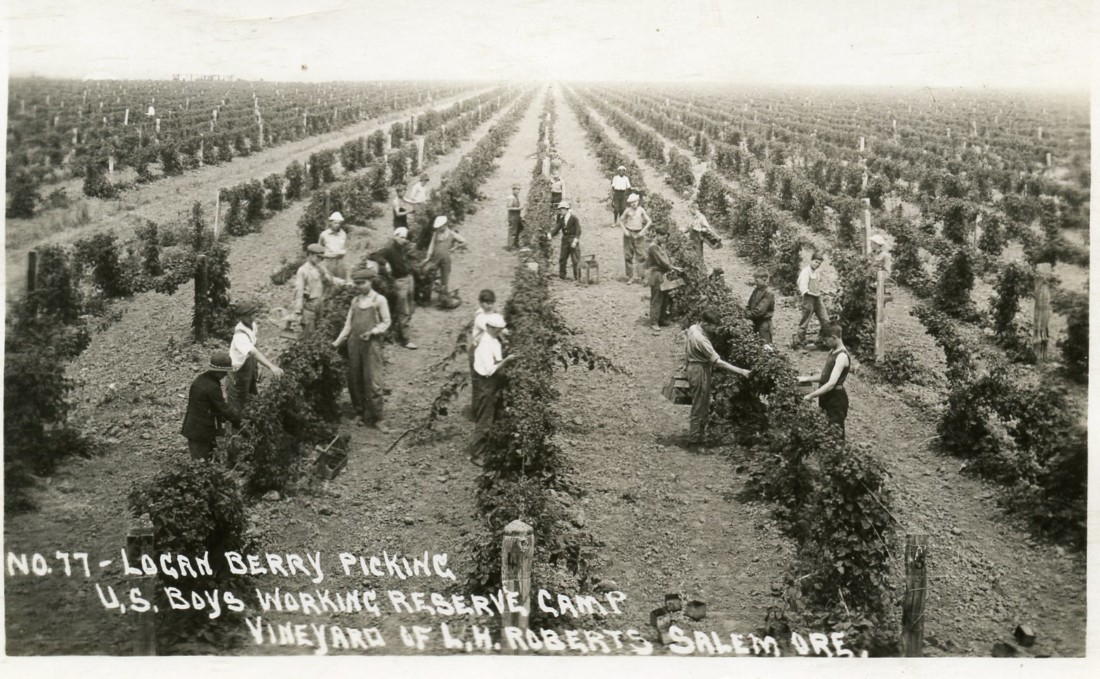
Loganberry picking in vineyard of L.H. Roberts, Salem, Oregon. WHC Collections 2011.006.0485. This photo had to have been taken sometime after 1917 as it features a WWI era labor program called “U.S. Boys Working Reserve.”
Farmers soon saw how well suited the Willamette Valley was for loganberry cultivation. One editor noted: “The Loganberry has an astonishing ability to grow vines in Oregon. The editor of this paper set a few plants in his garden last spring. These were so young and small that they did not look like much growth could be expected from them, but they have each sent out a number of long, strong vines, which were pinched off after they had grown to a length of from eight to 10 feet.”[14] Another editorial noted that “that delicious berry commanded a fancy price, and orders are still coming in which will be difficult to fill at any price.”[15]
Salem soon became the center of the growing industry.[16] As one advertisement grandly claimed (they did not cite their sources), “Eighty per cent of the loganberries of the world grow within thirty miles of Salem, Oregon.”[17] Another, more conservative estimate stated: “Salem folks should take pride in the fact that one-half the world’s logan crop is harvested within sight of the capitol dome.”[18]
Growing loganberries was no problem. Getting the berries to market was another story. National sales were the goal, but farmers were limited by the perishable nature of the berry.[19] Some turned to drying, others to juicing. Fresh picked berries could be packed with sugar right in the fields and then frozen and sent to factories to be made into juice or syrup months later anywhere in the country.[20] Even more economical in terms of transportation was to create the juice right here in Salem and ship the final, shelf stable product. This had the added advantage of keeping manufacturing dollars local.
A tale of two factories
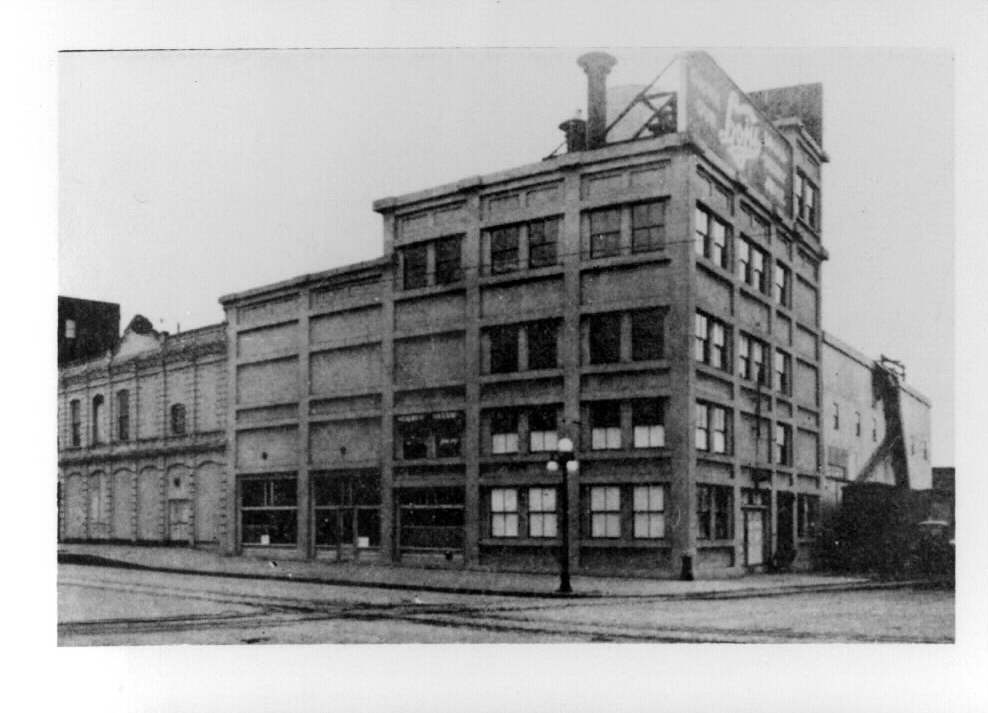
Plant that stood at the northeast corner of Commercial and Trade Streets. Originally built by the Salem Brewery Association as a Brewery, prohibition saw it take on new life as a Loganberry Juice factory. Note the “Loju” bill board on the southern facade.
WHC Photos 2004.010.0248
In 1915, two Salem companies incorporated and began large-scale production of loganberry juice in the city, just a few blocks apart and within days of each other.[21] The companies were spinoffs of older corporations – one brewery closed by local prohibition ordinances and one prune packing plant, but they both saw loganberry juice production as a good business move. At least in the case of the Salem Brewery Association, they were desperate to find a product to process in the plant they had invested a good deal of capital in and that was now standing idle.[22] And so the Northwest Fruit Products and the Oregon Fruit Products Companies were born.[23]
The Northwest Fruit Products company, utilizing the facilities (and key employees) of the former Salem Brewery Association at the northwest corner of Commercial and Trade streets (now the sculpture area near the Salem Conference Center) specialized in the creation of a beverage called “Loju.”[24]
The Oregon Fruit Products company had an early identity crisis and soon rechristened themselves the Pheasant Company and their product “Phez” because, “ we simply couldn’t make ourselves believe that hundreds of thousands of people would walk into the thirst parlors of the United States and say: ‘Give me a glass of Pheasant Brand Loganberry Juice.’”[25] Phez was sold as a concentrated solution and all marketing materials suggested mixing it with several parts water.[26]
National Markets
Marketing the new product was key to their success and both businesses started reaching out to “hotels, clubs, railroad companies, etc.” to get their products on tables and in people’s purview.[27] By some estimates $700,000 were put into national advertising campaigns.[28] They worked. Advertisements for Salem-made loganberry juice appears in newspapers from Vicksburg, Mississippi[29] to Moline, Illinois.[30]
Merger and End
In 1919, the two companies merged to form one.[31] Despite some successes, the juice market flagged in the 1920s. Like the fall of Rome, the reasons were many and complex and included contract disputes[32] and unexpected tax liabilities[33] that would be argued in the courts for years, and wildly fluctuating demand.[34] Or, to take the opinion of one local editorialist: “There is only one reason why [loganberry juice] is not going to every major port and to every country bordering all the oceans. That reason is want of organisation [sic] and cooperation; lack of able, honest leaders whom men who grow the fruit will follow, and keep on following, and keep on keeping on.”[35]
This article was written by Kylie Pine for the Statesman Journal newspaper. It appeared November 2, 2019. It appears here with citations, more images and explanation for reference purposes.
Sources
[1]Capital Journal 11 Aug 1916 pg 4
[2]“Salem is Dry by a Majority of 952 Votes.” 2 Dec 1913 pg 1. Should be noted that implementation did not go into effect until after court controversies. See “Drys Win all Cases before Highest Court.” Oregon Statesman 4 Feb 1914 pg1. “Progressive’s Covers Ideas” Oregon Statesman 4 Feb 1914 pg 1.
[3]“Last Wed Day Ends in Nationwide rush to stock up for dry spell.” New York Sun 1 July 1919, pg 2.
[4]Vintage advertisement for Phez. WHC 2011.027.0205 https://www.willametteheritage.org/phez-advertisement-2011-027-0205/#post/0
[5]“The Loganberry and Loganberry Industry for the Year 1919.” Oregon Statesman. 7 Oct 1920 pg 9.
[6]“For Sale.” Capital Journal. 30 Mar 1900 pg 3. “Berries were introduced by me in Salem market first last season. My plants are propagations from original stock. Gus. Freniard, Fairground Road opposite Murphy tile yard, little car line.”
[7]Should be noted that this claim was contested in a 1922 article. “Who Brought the Berry to Oregon?” Oregon Statesman 5 Oct 1922 pg 12. Which claims Dr. J. A. Richardson of Salem did in the early 1890s. No other contemporary newspaper corroboration could be found.
[8]“Loganberries” Oregon Statesman 3 Apr 1900 pg 5. Advertisement for Savage & Reid, Seedmen
[9]“Fred Lockley Tells the Story of the Life of Judge J.H. Logan.” Oregon Statesman 5 Oct 1922 pg 11.
[10]“The Loganberry and the Loganberry Industry.” Oregon Statesman. 9 Oct 1919 pag 3.
[11]“Earl Percy Gives General Review of the Great Loganberry Industry.” Oregon Statesman 5 Oct 1922 pg 12
[12]“The History of the Loganberry, the World’s Greatest Bush Fruit.” Oregon Statesman 6 Oct 1926 pg 10.
[13]“Fred Lockley Tells the Story of the Life of Judge J.H. Logan.” Oregon Statesman 5 Oct 1922 pg 11.
[14]Eugene Guard 2 Oct 1901 pg 2 Editorial.
[15]“Oregon Peach Crop.” Capital Journal Aug 9, 1902 pg 7.
[16]At least Salem claimed it was so. See articles like “The Loganberry Has Put Salem on the Map Forever and a Day.” Oregon Statesman 7 Oct 1920 pg 9. “The loganberry capital of the whole wide world is in Salem.”
[17]Vintage advertisement for Phez. WHC 2011.027.0205 https://www.willametteheritage.org/phez-advertisement-2011-027-0205/#post/0
[18]“Earl Percy Gives General Review of the Great Loganberry Industry.” Oregon Statesman 5 Oct 1922 pg 12
[19]“Big Loganberry Juice Pants in Operation.” Capital Journal 30 Jun 1915 pg 8. “Loganberry juice manufacture upon an extensive scale, one of the most important factors is relation to the loganberry industry from the standpoint of varied by-products of this luscious fruit, opened up in earnest in two big plants in this city of the first of the week and….which will very materially relieve the otherwise temporarily over-burdened market for the present season and will open up as avenue for a disposal of this product the future possibilities of which are beyond the power even of reasonable conjecture.”
[20]“Earl Percy Gives General Review of the Great Loganberry Industry.” Oregon Statesman 5 Oct 1922 pg 12
[21]“Big Loganberry Juice Pants in Operation.” Capital Journal 30 Jun 1915, page 8
[22]“Plan to Make Fruit Juices.” Oregon Daily Journal 23 Mar 1915 pg 10. “The plant represents a considerable investment and the stockholders do not want the institution to remain idle.” “Loganberries are known to thrive in the Willamette Valley soil…”
[23]“Big Loganberry Juice Plants in Operation.” Capital Journal. 30 Jun 1915 pg 8
[24]“Fruit Products Co. takes place of Salem Brewery Association.” Oregon Statesman. 1 Jun 1915. Advertisement. St. Louis Dispatch. 09 Sep 1917 pg 31
[25]“’So we Named it – Phez’ Makes it easy to ask for.” Oregon Statesman. 12 Apr 1916 pg 8; “Salem Becoming Loganberry Center.” Oregon Statesman 19 Mar 1916 pg 5
[26]“Oregon’s Famous loganberries.” Dispatch (Moline Illinois) 27 Jul 1917 pg 2
[27]“Big Loganberry Juice Plants in Operation” Capital Journal 30 June 1915 pg 8
[28]“The Great Surplus of the Future must go Into juice.” Oregon Statesman 7 Oct 1920 pg 9.
[29]Advertisement. 26 June 1920 Vicksburg Herald pg 6
[30]Advertisement. 27 Jul 1917 The Dispatch Moline, Illinois.
[31]Advertisement. Oregon Daily Journal 8 Aug 1919. page 22 “This note issue of the Phez Company is the consummation of a complete consolidation of the Northwest Fruit Products Company and the Pheasant Fruit Juice Company, the former parent companies. “ Although it may be that the merger really didn’t take effect until 1921 – “Northwest Fruit Co. to take over Salem Loganberry Concern.” Albany Evening Herald 22 Jun 1921 pg 3 “After July 1 the loganberry business of Phez company will be carried on by a new corporation recently organized and known as the Northwest Fruit Products Company…This company bears the same name as a former company now dissolved. The new corporation has leased the Loju plant from the Phez company and will conduct all this portion of the business independently from the old corporation.”
[32]“Phez Judgement Reversed.” Capital Journal 10 Feb 1925 pg 1; “Rehearing may be asked by Phez Company.” Capital Journal 11 Feb 1925 pg 8. “Reopening of Phez Case Likely, is Opinion Here” Oregon Statesman 12 Feb 1925 pg 8.
[33]“Loju, Phez Ruled Upon.” Oregon Statesman 20 Dec 1927 pg 1; “Bits of Breakfast.” Oregon Statesman 11 June 1934 pg 4.
[34]“Outlook for Loganberry Industry is Better than Last Year, Says Expert.” Oregon Statesman 7 Oct 1928 pg 18. “Surplus Loganberry Pack Under that of Last Year.” Oregon Statesman 7 Oct 1928, pg 18.; “Bits of Breakfast.” Oregon Statesman 11 June 1934 pg 4; Oregon Statesman 18 Aug 1929 pg 21.
[35]R.J. Hendricks. “Bits for Breakfast.” Oregon Statesman 11 Jul 1934 pg 4.



